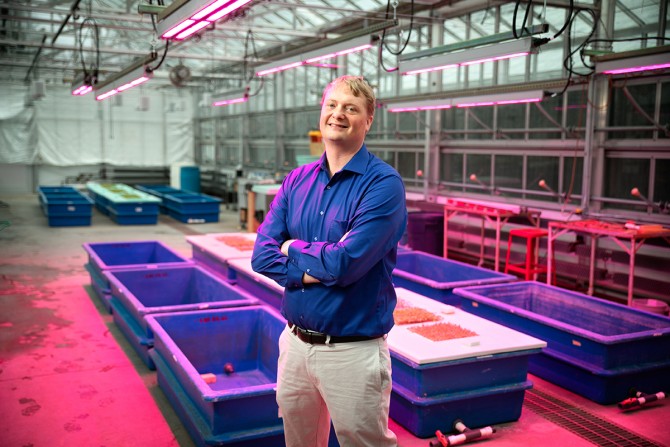
A commercial controlled-environment agriculture greenhouse operation producing leafy greens in eastern New York.
Viability of indoor urban agriculture is focus of research grant
By Krishna Ramanujan
Growing crops in controlled environments – in greenhouses, plant factories and in vertical farms – provides alternatives to conventional farming by producing food year-round near metropolitan areas, reducing transportation costs and water use, and improving land-use efficiency. Such local systems also offer valuable educational and psychological benefits by connecting urban people to the food they consume.
At the same time, there is little concrete evidence to show how so-called controlled-environment agriculture (CEA) compares to conventional field agriculture in terms of energy, carbon and water footprints, profitability, workforce development and scalability.
Cornell will lead a project to answer these questions, thanks to a three-year, $2.4 million grant from the National Science Foundation, through its new funding initiative called Innovations at the Nexus of Food, Energy and Water Systems.
“By putting all these pieces together – including energy, water, workforce development and economic viability – we hope to discover if CEAs make sense for producing food for the masses,” said Neil Mattson, the grant’s principal investigator and associate professor in the Horticulture Section of the School of Integrative Plant Science.
Six projects included in the grant will look at:
Case studies: Food system analysis of case studies in metropolitan areas will examine where vegetables are currently sourced and the market channels they go through to reach consumers, such as supermarkets, retailers or restaurants. Researchers will model whether urban CEAs could replace a large fraction of this produce, and whether it makes sense for CEA produce to go through the same market channels or other ones that may suit them better. This project is led by Miguel Gómez, associate professor, and Charles Nicholson, adjunct associate professor, both in Cornell’s Dyson School of Applied Economics and Management.
Computer modeling of energy and water use: Computer models of energy and water use for different crops in greenhouses, vertical farms and plant factories (indoor environments with artificial lighting and racks of plants) will be developed. The models will be calibrated with real-world data from greenhouse growth trials at Cornell and the Rensselaer Polytechnic Institute (RPI). A 2008 study by Lou Albright at Cornell found that based on that year’s technologies, the carbon footprint to produce lettuce in a greenhouse in New York state was twice that of growing it in a field in Arizona or California. Other researchers have reported that CEAs use 20 times less water than field agriculture, since water can be recycled indoors. Mattson leads this effort with research associate Kale Harbick, also in the Horticulture Section of the School of Integrative Plant Science.
Networking: The project will foster industry-to-research networks for facilitating the acceptance, adoption and improvement of metropolitan CEA systems. Anusuya Rangarajan, senior extension associate, will lead this project.
Nutritional value: Researchers will examine the nutritional value of produce from greenhouses and plant factories and comparing those values with CEA systems where lighting might be optimized for more healthful produce. Project leaders include Marianne Nyman, associate professor of civil and environmental engineering, and Tessa Pocock, a senior research scientist, both at RPI.
Workforce needs: Cornell researchers are collaborating with the Association for Vertical Farming to assess the workforce needs of the urban CEA industry and develop programs to meet those needs and test if requirements are being met. Researchers will examine if, for example, all the tomatoes consumed in New York City were to be grown indoors, how many jobs at what education levels and training would be needed. Rangarajan leads this effort.
Training opportunities: Rangarajan and the Association for Vertical Farming will also create workforce training opportunities. They will spearhead outreach through conferences and events to share information. A forthcoming website will house a toolkit to assess the viability and resource availability of proposed urban agriculture projects.
“Urban agriculture is an increasingly touted way to connect producers with consumers, and this grant will help guide full development of this industry and do better to figure out where the best opportunities might be, as well as cases where it doesn’t make sense,” Mattson said.
Media Contact
Get Cornell news delivered right to your inbox.
Subscribe